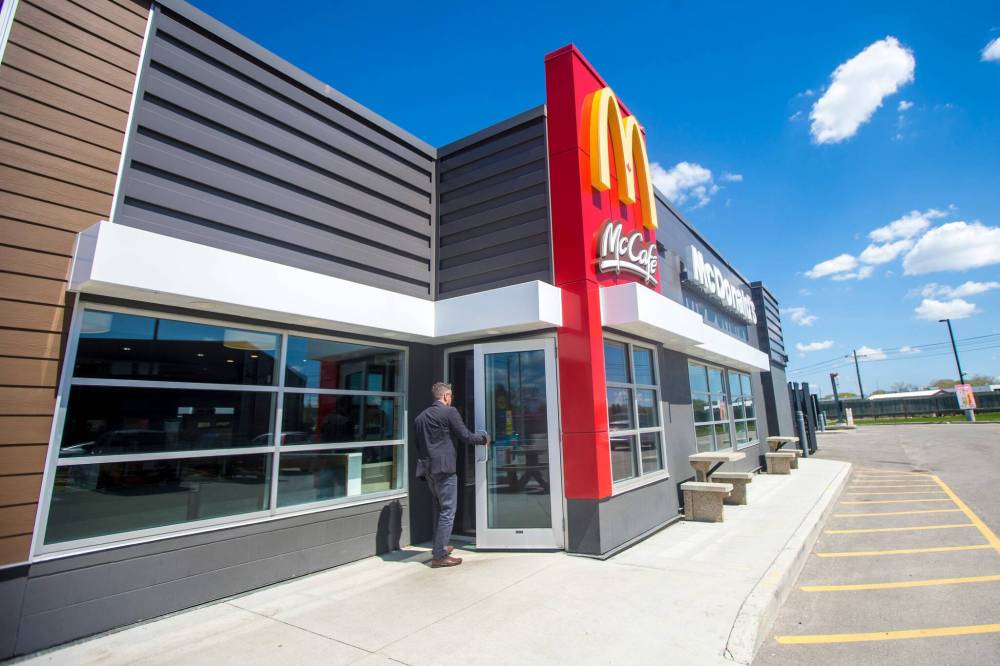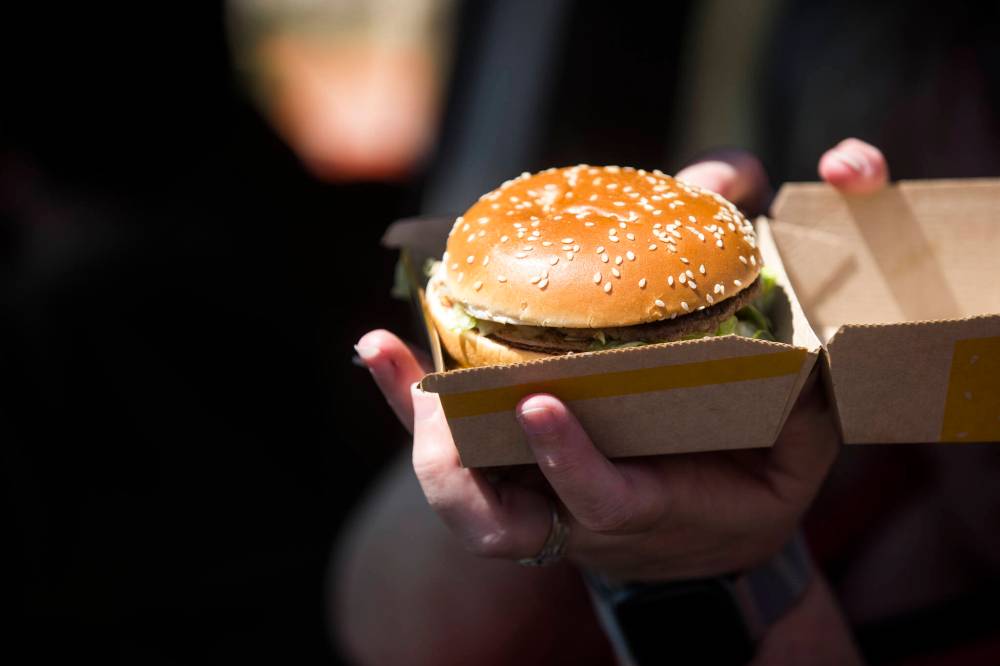Burgernomics, with a side of shrinkflation Inflation has super-sized a Big Mac’s bite on the average consumer’s wallet
Read this article for free:
or
Already have an account? Log in here »
To continue reading, please subscribe:
Monthly Digital Subscription
$19 $0 for the first 4 weeks*
- Enjoy unlimited reading on winnipegfreepress.com
- Read the E-Edition, our digital replica newspaper
- Access News Break, our award-winning app
- Play interactive puzzles
*No charge for four weeks then billed as $19 plus GST every four weeks. Offer only available to new and qualified returning subscribers. Cancel any time.
Read unlimited articles for free today:
or
Already have an account? Log in here »
Hey there, time traveller!
This article was published 23/05/2022 (948 days ago), so information in it may no longer be current.
You won’t be lovin’ it if soaring inflation pushes the cost of a McDonald’s Big Mac to eight bucks by the end of the year.
And if you want fries with that, you might be looking at a smaller serving size thanks to shrinkflation.
The average price of a Canadian Big Mac could jump to about $8, an 18.5 per cent increase in less than a year, according to HelloSafe’s Big Mac Index.
Top 26 most expensive countries to buy a Big Mac, in CAD
Canada is the seventh most expensive country for buying a Big Mac, according to HelloSafe’s index.
1. Switzerland, $8.85
2. Norway, $8.10
3. United States, $7.37
4. Sweden, $7.30
5. Uruguay, $6.90
6. Israel, $6.80
7. Canada, $6.70
8. Venezuela, $6.40
18-way tie for ninth (at $6.30 CAD each)
● Austria
● Belgium
● Cyprus
● Estonia
● Finland
● France
● Germany
● Greece
● Ireland
● Italy
● Latvia
● Lithuania
● Luxembourg
● Netherlands
● Portugal
● Slovakia
● Slovenia
● Spain
Top 10 least expensive countries to buy a Big Mac, in CAD
● Russian Federation, $2.20 (note: this was taken pre-Russian invasion in Ukraine and before McDonald’s announced its exit from the country)
● Turkey, $2.40
● Indonesia, $3.00
● Malaysia, $3.00
● Romania, $3.00
● Ukraine, $3.10
● India, $3.20
● South Africa, $3.30
● Azerbaijan, $3.40
● Egypt, $3.40
HelloSafe, an insurance comparison platform, has published the index for two years. The Big Mac Index was invented by The Economist in 1986 as a lighthearted way to measure disparities in consumer purchasing power between nations, with the iconic burger replacing the traditional basket of goods.
“We have made price estimates based on several factors, all related to the inflationary context and the war in Ukraine,” a HelloSafe spokeswoman wrote in an email.
The company factored in the rising prices of meat, flour, cereals, dairy, oil, mustard and fuel.
On Tuesday, a Big Mac at a Pembina Highway McDonald’s cost $5.99. The national average at the beginning of the year was $6.70, up 20 cents from January 2021’s $6.50.

“You can’t raise your hamburger prices too quickly, too aggressively. People will notice and you’ll lose your market share,” said Sylvain Charlebois, a Dalhousie University professor of food distribution and policy.
That’s where shrinkflation enters.
“The hamburger itself has to look healthy,” Charlebois said. “It has to look generous. If you can cut on whatever is around the hamburger… that’s what’s going on.”

It means reducing the number of fries given in an order and shrinking other sides. The practice is being used across Canada, Charlebois said.
Manufacturers have also turned to smaller packages to avoid raising prices, affecting people’s grocery hauls.
“Packaged (products) — anything with grams or millilitres — would’ve seen some shrinkflation going on,” Charlebois said.
Tillamook Ice Cream, an Oregon-based business, made a public statement about its decision to reduce its ice cream carton size from 56 oz. to 48. Ingredients’ skyrocketing costs meant a choice between raising ice cream prices or switching packaging.
“We decided to choose the latter so that the affordable cost per carton of ice cream did not change,” Tillamook’s post reads.
Gatorade has phased out its 32-ounce bottles to sell 28-ounce versions, according to a U.S. Bloomberg report. The company maintains the change is partially for an easier-to-grip bottle size.
Bloomberg lists Domino’s Pizza and Burger King as businesses who’ve reduced some chicken nugget meal portions to cut costs south of the border.
Food prices will likely continue to rise over the next several months, Charlebois said.
“(It’s) hard to predict,” he noted. “The war in Ukraine started a new inflation cycle.”

Tony Vailas and his father have opted not to reduce portion sizes at Daly Burgers. But, it means raising menu prices to stay viable.
“We just have to keep adjusting things as we go,” the co-owner said. “It’s tough when you have to face that customer, and you’re starting to break new barriers where certain items come to… above $10.”
Still, many items are below $10. The volume of customers keeps prices down, Vailas said. He’s concerned about ingredients’ costs continuing to climb, leading to Daly Burgers’s offerings becoming more expensive.
“It’s like hitting an iceberg with a big ship,” Vailas said. “We can see the iceberg, but we can’t move out of the way.”
A 16-litre box of canola oil that used to cost the restaurant $19 is now $44, he said.
“We really don’t want to start cranking the prices,” he said, adding he hasn’t seen a drop in customers.
Joey Biondi walked out of a McDonald’s on Pembina Highway with a Big Mac (extra cheese) Tuesday.
His order would be different if the burger was $8, he said.
“It wouldn’t be of value anymore, at the size it is, for the price,” he said.

Biondi visits the fast food chain once a week for lunch; it’s near his work.
“If prices go up across the board (at McDonald’s), it’s more likely that I’d be shopping for lunches (at a grocery store) rather than fast food,” Biondi said.
Jacquie Cumming, who also ordered a Big Mac during the noon hour Tuesday, called the forecasted $8 “ridiculously steep”.
She said she remembers the burger costing $1 decades ago.
“Everything’s going up,” said McDonald’s customer Harley Henschell. “It is what it is. (You just) have to budget more.”

Canada is the seventh most expensive country for buying a Big Mac, according to the index. Switzerland takes top spot with an average $8.85 CAD per burger; the United States is third at $7.37 CAD.
The Big Mac price map includes seventy-three countries.
HelloSafe based its forecast on meat prices rising 7.91 per cent, flour 10.93 per cent, cereals 7.47 per cent, creamery products 3.78 per cent, oil 9.98 per cent and mustard 9.26 per cent.
The burger forecast is subject to change, the company’s spokeswoman wrote.
Canada’s overall food prices went up 9.7 per cent year-over-year last April. Fuel at the pump increased 36.3 per cent, while fuel oil increased 64.4 per cent.
gabrielle.piche@winnipegfreepress.com
Visit HelloSafe Canada for more tools.History
Updated on Wednesday, May 25, 2022 10:47 AM CDT: Corrects typo





